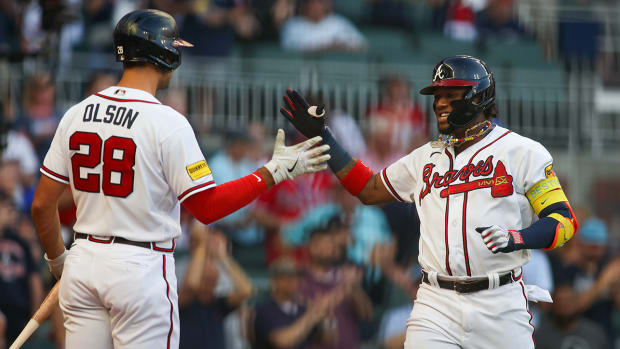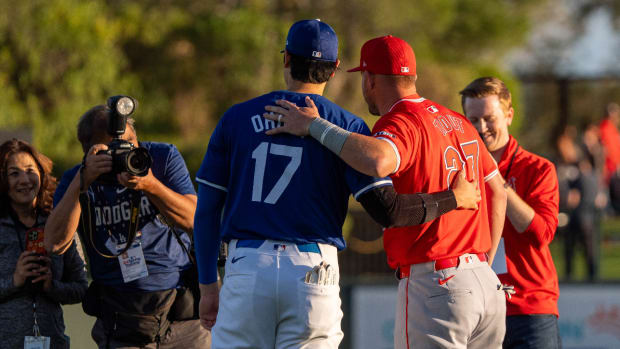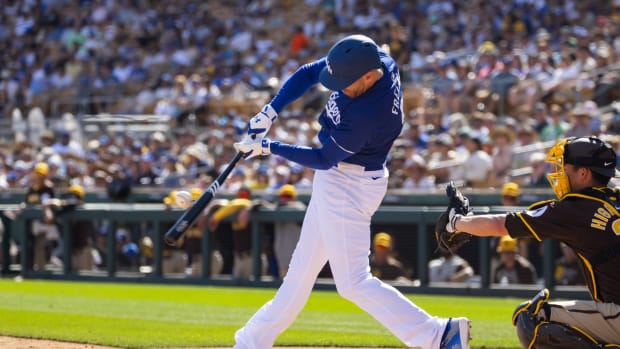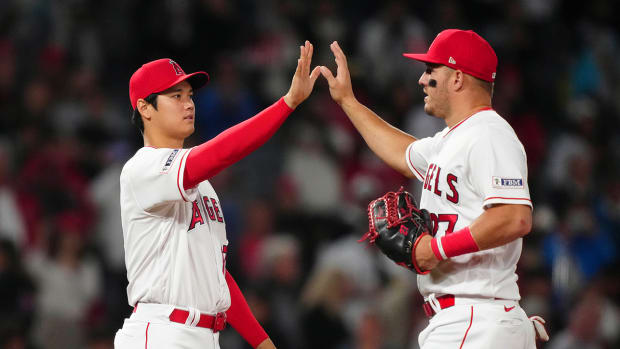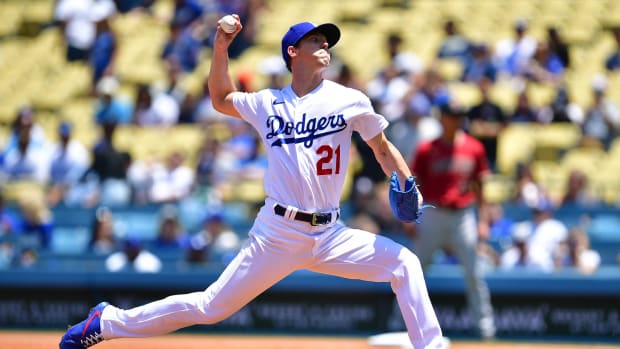Worst MVP Follow-Up Seasons in Baseball History
You're going to go immediately to Cody Bellinger whether I put his name in the headline or not, so let's not pussyfoot around.
The Dodgers centerfielder and reigning National League Most Valuable Player Award winner is off to a miserable start to the 2020 season. Whether it's a direct result of Bellinger tinkering with his stance during the winter or simply a bad stretch of games, which can happen to anyone, we can't say for sure.
But the pressure is mounting and the young man feels it. His manager and teammates feel it for him, and miss the production. The league tilts its head in disbelief and it isn't pretty no matter how you look at it, with the possible exception of with a Dodger-blue neck gaiter pulled over your eyes.
These are the numbers: 17 games, 77 plate appearances, 72 at bats, 11 runs, 12 hits, one double, two home runs, six RBIs, one steal, five walks, 11 strikeouts and a .167/.221/.264 batting line.
Here are the numbers at the 17-game mark last year: 76 PA, 66 AB, 22 R, 28 H, 3 2B, 1 3B, 9 HR, 22 RBIs, 10 BB, 22 RBIs, 1 SB and a .424/.500/.909. Bellinger would go on to win the NL MVP with 47 homers, 115 RBIs and a .305/.406/.629 mark.
But the point of this exercise isn't to compare one man's performance to his own as much as it is a look at how Bellinger's 2020 season compares in the history of MVP follow-ups. The obvious caveat is that with Bellinger we're looking at a snapshot in time, not an entire 154 or 162-game season, as was the sample size with of his predecessors. And, of course, we have no idea how it'll turn out in the end.
My plan was to survey the MVP landscape for a round-number 60 years of history, from 1960 through 2019. When I couldn't find much to match all that closely to Bellinger's season thus far, I expanded my view to the entire list of MVPs, going all the way back to 1911, when Ty Cobb and Frank Schulte were the inaugural winners of the AL and NL MVP winners, respectively.
The MVP list is filled with names like Trout and Pujols and Bonds and Rodriguez. Like Griffey, Jr., Ripken, Henderson and Yount. Brett, Schmidt, Jackson, Rose, etc. Yastrzemski, Robinson (Frank and Brooks), Mantle, Maris, Aaron and Mays. Berra, Campanella, Williams and Robinson (Jackie). Musial, DiMaggio, Foxx, Hornsby, Johnson (Walter) and Ruth. A list filled with Hall of Famers, not a one of whom ever had an MVP follow-up season to raise an eyebrow about. Not really.
The truth is, out of the entire list of MVPs -- 195 of them -- there is no follow-up season that looks much like Bellinger's 2020 campaign. Again, of course, with the understanding that it's only 17 games -- 17 games -- and it's possible that Bellinger will turn his season around beginning tonight versus San Diego at Dodger Stadium.
That said, for the sake of history, and because it's an interesting list, here is what I came up with, in reverse chronological order:
1988 NL MVP Award winner Kirk Gibson, Los Angeles Dodgers. Gibson, famously, led the Dodgers to the World Series championship after injuring both of his legs, famously, in the National League Championship Series and was never the same again. He went from a 25-homer, 76-RBIs, .290/.377/.483 season to a 9 HR, 28 RBI, .213/.312/.368 follow-up while appearing in only 71 games.
1986 NL MVP Willie McGee, St. Louis Cardinals. An NL-leading 216 hits, 18 triples and .353 batting average, complemented by a .384 on base percentage and a .503 slugging, 56 stolen bases, 114 runs, 10 home runs and 82 RBIs. The follow-up: 127 hits, a .256/.306/.370, with 7 HR, 48 RBIs, 65 runs and 19 steals.
1979 NL Co-MVP, Willie Stargell, Pittsburgh Pirates. Stargell shared the award with the Cards' Keith Hernandez in 1979, leading his "we are family" Bucs to the championship with 32 home runs, 82 runs batted in and a .281/.352/.552 line in 424 at bats in 126 games. In 1980, the popular Hall of Fame first baseman hit 11 homers, with 38 RBIs and a .262/.351/.485 line. At the age of 40.
1974 AL MVP , Jeff Burroughs, Texas Rangers. Burroughs had some fine seasons, the highlight of which was the 1974 campaign, in which he recorded 25 home runs, 118 RBIs and a .301/.397/.504 batting line. The production returned in '75 (29 HR and 94 RBIs), but the batting line did not (.224/.347/.348).
1965 AL MVP Zoilo Versalles, Minnesota Twins. Versalles wasn't the greatest MVP in the world, but he did lead the AL in six categories (one of them being strikeouts) in 1965. He was good for 728 plate appearances, 126 runs, 182 hits, 45 doubles, 12 triples, 19 homers, 77 RBIs and a .273/.319/.462 line. In 1966? Seventy-three runs, 135 hits, 20 doubles, six triples, seven homer, 36 RBIs and a .249/.307/.346.
1952 AL MVP Bobby Shantz, Philadelphia A's. 24-7, 2.48 ERA, 33 starts, 27 complete games, 1.048 WHIP in 1952. 5-9, 4.09, 16 GS, 6 CG and 1.259 in '53.
From SABR: "On May 21, 1953, pitching against the Red Sox, Shantz injured his left shoulder. A tendon had separated from the bone, and it was the beginning of three difficult years. His shoulder eventually healed, but it would require treatment for the remainder of his career."
1950 NL MVP, Jim Konstanty, Philadelphia Philies. A relief pitcher MVP in his career year, Konstanty led the sport in appearances (74), games finished (62) and saves (22), when saves were harder-earned than they are now (152 innings in this case, a bit more than two innings per outing). Konstanty posted a 16-7 won/loss, a 2.66 ERA and a 1.039 WHIP. The result was an NL pennant for him and his mates, affectionately known as the Whiz Kids.
Konstanty led baseball in games finished (45) in 1951, but the rest of statistics were considerably less shiny: 4-11, 4.05. 1.366 and nine saves.
1943 AL MVP Spud Chandler, New York Yankees. Chandler won the Cy Young Award as well in 1943, with a 20-4 record, led baseball with an .833 winning percentage, a 1.64 ERA and 0.992 WHIP, plus an AL-leading 20 complete games and five shutouts. He won both his starts in New York's World Series triumph over St. Louis, completing both games with an 0.50 ERA. He made all of one April, 1944 start (6 IP, 3 ER and a no decision), spending the rest of the season in the Army.
1942 AL MVP Joe Gordon, Yankees. Hall of Famer Gordon hit .322/.409/.491 with 18 HR and 103 RBIs in 1942; fell to .249/.365/.413, 17 and 69 in '43. Bellinger would probably take those numbers, or the 60-game equivalent of, but he's not there now.
1926 AL MVP George Burns, Cleveland. Led baseball with 216 hits and 64 doubles and recorded a .358/.394/.494 mark. Managed only a .319/.375/.435, 175-hit, 51-double follow-up in 1927. Yeah, Burns probably doesn't belong on this list. Please forgive me. Say goodnight, Gracie.
1925 AL MVP Roger Peckinpaugh, Senators. After hitting .294/.367/.379 with four homers and 64 RBIs -- yes, that was good enough for an MVP in 1925; no, he's not a Hall of Famer -- Peckinpaugh followed-up with one-HR, 14-RBI season, .238/.360/.299, 57-game campaign at age 35 and retired a year later.
1922 AL MVP George Sisler, St. Louis Browns. Hall of Famer Sisler hit .420/.467/.594, with 134 runs, 246 hits, 42 doubles, 18 triples, eight homers, 105 RBIs and 51 steals. Sisler "missed the entire 1923 season with a severe sinus infection that impaired his optic nerve, plaguing him with chronic headaches and double vision."
Eleven men out of 195. Bellinger isn't 40 like Mr. Stargell, he doesn't have a set of bad wheels ala Gibby and there is no issue with the optic nerve, as with Sisler. But he is a genuine Most Valuable Player Award winner, he is a real live Rookie of the Year, a two-time All-Star, a Gold Glove and Silver Slugger winner. And he's not going to hit .167 and OPS .485. He's not. I'm almost sure of it.
And remember, glove conquers all.
Howard Cole has been writing about baseball on the internet since Y2K. Follow him on Twitter.
[Follow Sports Illustrated’s Inside the Dodgers on Twitter.]
